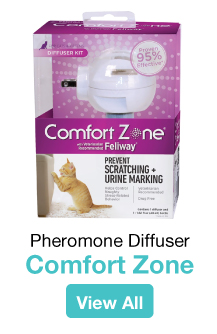
Hot Spots in Dogs and Cats
Hot spots are areas of pyoderma , or bacterial skin infections, in dogs and cats that cause an extremely red, inflamed area of hairless skin. Often, this patch of skin looks as though it is wet and may even feel moist. These lesions can appear suddenly and can expand rapidly, as they are caused by a bacterial infection. Anything that irritates or breaks the skin can create the environment for bacterial contamination if the skin surface has just a bit of moisture on it. Hot spots are also often characterized by small bumps or blisters protruding from the infected area.
Hot Spots can afflict dogs and cats of all ages and breeds. Due to the nature of the origin of the problem, hot spots can be caused and spread in a variety of ways. For similar reasons, there are a wide variety of ways that pyoderma can be treated. Thus, the cause of your petís pyoderma will greatly influence the way in which you and your vet will decide to treat it.
What Causes Hot Spots?
Though pyoderma is an infection on your petís skin, said infection can be caused either by a lapse in your petís immune system, leading to a surplus of normal skin bacteria; or, it can be caused by the introduction of a foreign irritant bacteria culture, which capitalizes on a similar weakness in your skinís defenses.
A hot spot starts because something irritates the pet's skin. The body's response is to either itch or create an inflammatory response at the site. In cases of itching, the pet then rubs, licks or chews the site and adds to the problem by further damaging the skin and making it ripe for infection to spread.
Fleas and allergies are two of the most common irritants among a myriad of others. These irritants in particular cause the itching that leads to most skin infections. Among the other possible sources of irritation are tick bites, bee stings, mosquitoes, summer heat and other problems all contribute to the initial irritation that can develop into a hot spot.

Diagnosis
To have your pet formally diagnosed with pyroderma, bring him or her to a veterinarian and your vet will examine the infected area. Medical history will be factored into the diagnosis as well as your petís visible symptoms and his or her blood work. Your veterinarian might also take an allergy test to see if your petís skin condition is the result of an allergic reaction.
If it does turn out to be a hot spot then your veterinarian will likely take additional steps to determine the best course of treatment. There are a variety of treatments that work in different ways for differing conditions. Most treatment options involve using antibiotics to combat the infection and typically require administration for upwards of 4 weeks.
Treatment
Despite most solutions being antibiotics, there are a variety of forms in which antibiotics can be administered and some treatments vary based on instructions, dosing and strength. Some medicines are ingested orally while others are topical solutions. There are a variety of factors to consider when searching for the correct antibiotic to treat your pet:
- Type of infection
- Depth of infection
- Cost of antibiotic
- Administration method
- Administration frequency
- Potential Side Effects
Shaving of the affected area is mandatory in most treatments and it is important to make sure that it is treated properly or else the infection will reoccur. For an atypical case of pyoderma, your veterinarian may decide to take a bacterial culture of your petís infection to determine future action. This would likely be saved for infections that do not respond to traditional antibiotics.
The traditional method for treating hot spots is by applying topical solutions to your pet in the following manner:
- Shaving is followed by flushing the surface of the affected skin with an antiseptic solution
- Bathe the pet with an antiseptic shampoo
- Bathing can be followed by a topical anti-inflammatory spray applied on the hot spot once or twice daily.
- Consult with your veterinarian about following up this process with an anti-parasitic shampoo

Prevention
The best way to deal with hot spots is to make sure they never develop. There are a variety of preventative measures you can take to stop your pet from developing these infections. The first step is to ensure that they are groomed properly. Matted fur can lead to moist areas where insects can inhabit and this can lead to skin irritation and eventual infection.
In addition to grooming, Elizabethan collars that prevent your pet from scratching afflicted areas also work to ensure that skin irritations do not develop into full blown hot spots. By preventing your pet from scratching their itch, these collars work to prevent the infection of irritated areas.
Lastly, the behavior that leads to hot spots, such as scratching and irritating skin may be the result of your petís boredom or stress. Consider consulting with a pet behaviorist to determine the cause of the problem. If it is behavior related, you can use a pheromone diffuser to put your pet at ease and consult with the behaviorist for additional advice.


Sources
- Vetinfo, Dogs: Skin and Hair Conditions"Canine Pyoderma: Hot Spots on Dogs". Retrieved Oct 2013.
- The University of Tennessee Institute of Agriculture UT DermVet"Pyoderma". Retrieved October 2013.
- Vetinfo, Dogs: Skin and Hair Conditions
